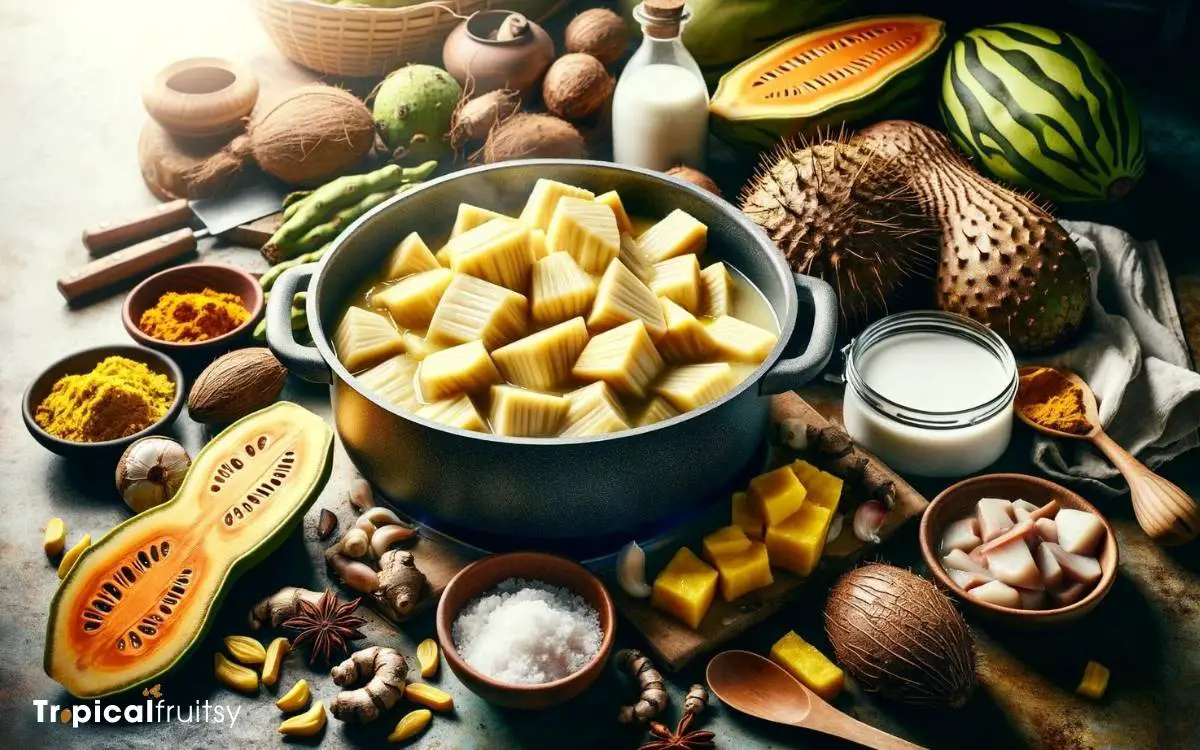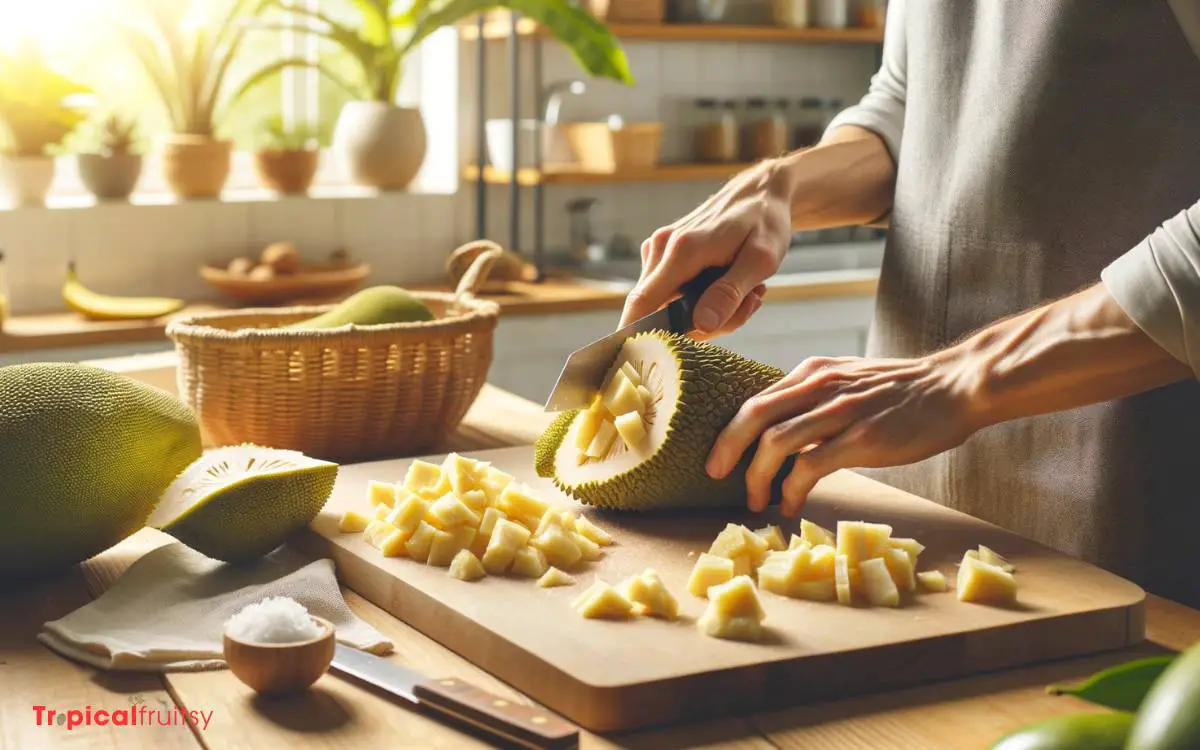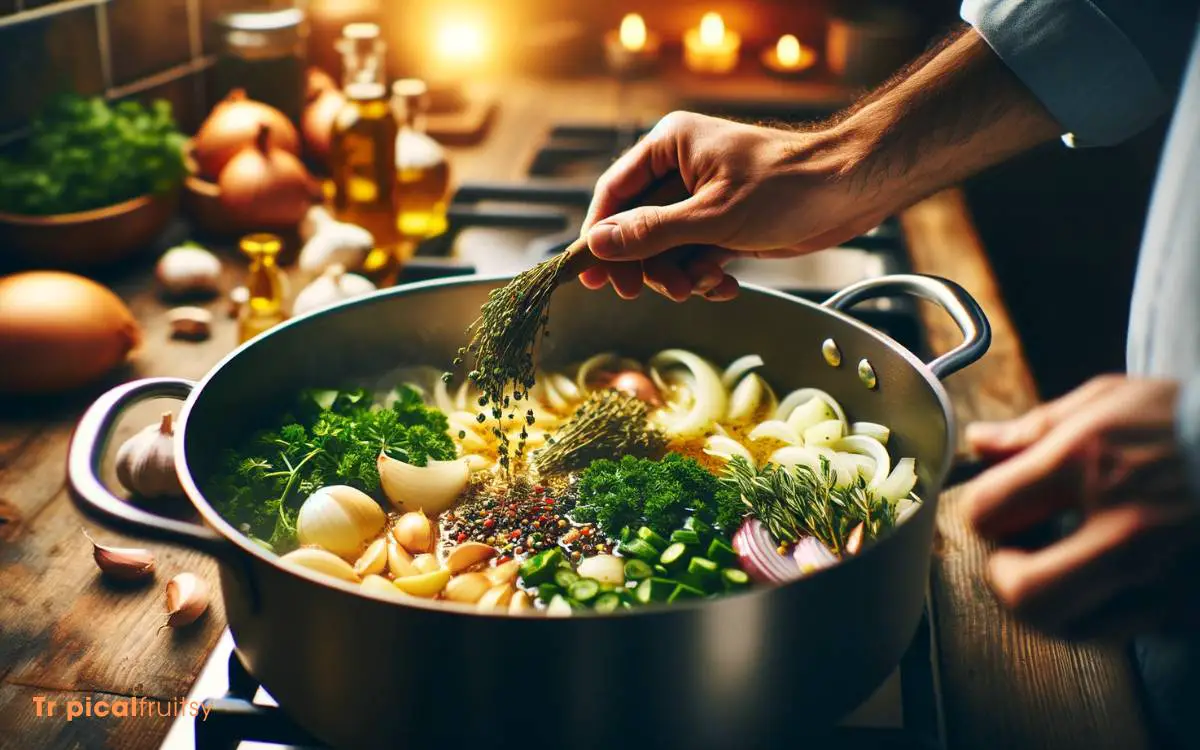How to Make Breadfruit Oil Down? 4 Easy Steps!
Breadfruit Oil Down is a cherished culinary tradition in the Caribbean, renowned for its rich flavors and communal preparation.
This staple dish centers around the breadfruit, a starchy tropical fruit that, when cooked, offers a potato-like texture.
Crafting this savory meal requires a methodical approach, beginning with the selection of ripe breadfruit, fresh herbs, salted meat, and coconut milk, which form the foundational elements of the recipe.
The cooking process involves sautéing aromatic ingredients to release their fragrances, followed by layering these with breadfruit and other components in a single pot.
Gently simmering the mixture allows the ingredients to meld, creating a harmonious balance of flavors.
This introduction aims to guide enthusiasts through the nuances of preparing Breadfruit Oil Down, ensuring a delightful gastronomic experience that resonates with the dish’s cultural significance.

Key Takeaway
Gathering Your Ingredients
Before embarking on the preparation of Breadfruit Oil Down, it is essential to assemble all necessary ingredients. These ingredients include a ripe breadfruit, salted meat, coconut milk, onions, garlic, and fresh herbs.
The breadfruit should be mature and yield slightly to pressure, its green skin tinged with yellow. Your choice of salted meat could range from pork to cod, its savory notes imparting depth to the dish.
Coconut milk, rich and creamy, serves as the luscious base, while onions and garlic contribute their pungent aromas. Freshly plucked herbs like thyme or chives infuse the ensemble with vibrant, aromatic whispers.
Each component is pivotal, entwining to create a symphony of flavors that characterize this traditional Caribbean feast.
Step 1: Preparing the Breadfruit

To initiate the preparation of Breadfruit Oil Down, each breadfruit must be peeled, cored, and cut into large chunks.
This is a pivotal step, ensuring that the breadfruit absorbs the rich, savory flavors of the dish while maintaining a satisfying texture.
The process is straightforward, yet it requires a meticulous approach to preserve the integrity of this tropical staple.
Here are the essential steps to prepare the breadfruit:
- Peel the skin: Remove the green outer layer to reveal the creamy flesh beneath.
- Core the fruit: Extract the heart of the breadfruit, which is not typically consumed.
- Slice into sections: Divide the breadfruit into large, even wedges.
- Chunk the slices: Cut the wedges into sizable chunks, optimal for even cooking and flavor absorption.
Executing these steps with care will lay a solid foundation for a delightful Breadfruit Oil Down.
Step 2: Sautéing the Aromatics

Having prepared the breadfruit chunks, the next critical step in creating Breadfruit Oil Down is to sauté the aromatics, which will lay the flavor foundation for this traditional dish.
Begin by heating a generous amount of coconut oil in a deep, heavy pot over medium heat. Once shimmering, add finely chopped onions, allowing them to soften and become translucent, a process that releases their natural sweetness.
Introduce minced garlic and slivers of scotch bonnet pepper, cooking them until their pungent fragrances meld harmoniously.
Stir in chopped pimento peppers, known for their mild yet distinct flavor, and thyme leaves, which will provide an earthy and slightly minty note.
This mixture must be sautéed until it’s richly aromatic, ensuring the breadfruit will absorb these layered flavors during its simmer.
Step 3: Layering the Pot

After sautéing the aromatics, the next step is to strategically layer the ingredients in the pot, starting with a single layer of breadfruit chunks at the bottom.
This foundational layer will absorb the rich flavors and spices as they meld during the cooking process.
To create a symphony of taste and texture, consider the following sequence:
- Place salted meat or fish atop the breadfruit, allowing its savory juices to permeate the layers.
- Intersperse slices of carrot and bell pepper for a sweet, earthy note and a burst of color.
- Add whole okra on top, which will steam gently, infusing the dish with its subtle, grassy essence.
- Tuck sprigs of fresh thyme among the layers, which will impart a fragrant, herbal complexity to the dish.
Each ingredient is selected not only for its individual flavor but also for how it complements and contrasts with the others, creating a harmonious Oil Down that is authentic, detailed, and rich in Caribbean culinary tradition.
Can Breadfruit Chips be used as an ingredient in Breadfruit Oil Down?
Breadfruit chips can indeed be used as an ingredient in Breadfruit Oil Down. To prepare, start by making crispy breadfruit chips using the method of “how to fry breadfruit chips.” Once done, add the chips to the rich, flavorful Breadfruit Oil Down for an added crunch and unique texture that complements the dish perfectly.
Step 4: Simmering to Perfection

Upon layering the ingredients, cover the pot and allow the Oil Down to simmer gently, ensuring the flavors meld and the breadfruit becomes tender without disintegrating.
The art of simmering is pivotal—it is the slow dance of heat through the pot, the quiet confluence of spices, coconut milk, and the subtle sweetness of the breadfruit.
As steam whispers from the edges of the lid, resist the urge to peek too often; each lift allows precious aromas to escape.
Instead, trust in the low, even heat to envelop the ingredients, each minute enhancing the depth of the dish.
A spoonful of patience here is essential, as the true essence of Oil Down emerges not from a rushed boil, but from a harmonious and measured simmer.
Conclusion
The culinary craft of creating breadfruit oil down beckons with its blend of bold flavors and textures.
This traditional tropical treat tempts with its tapestry of tender breadfruit, aromatic spices, and succulent salted meat, all simmered slowly to succulence.
The stratified structure of the simmered ingredients in the pot promises a palate-pleasing experience in every spoonful, making the meticulously made meal a revered repast rooted in rich cultural heritage.






